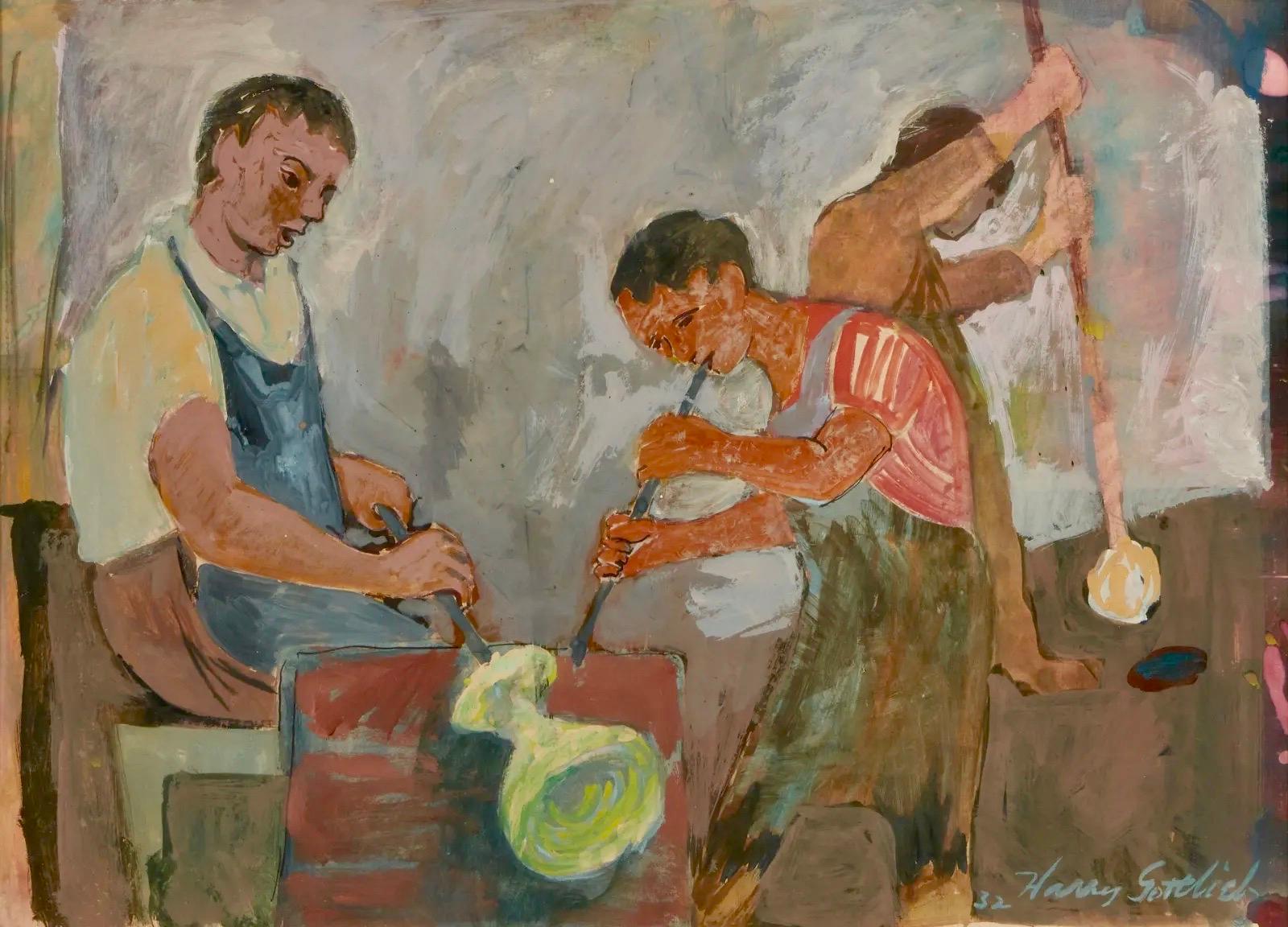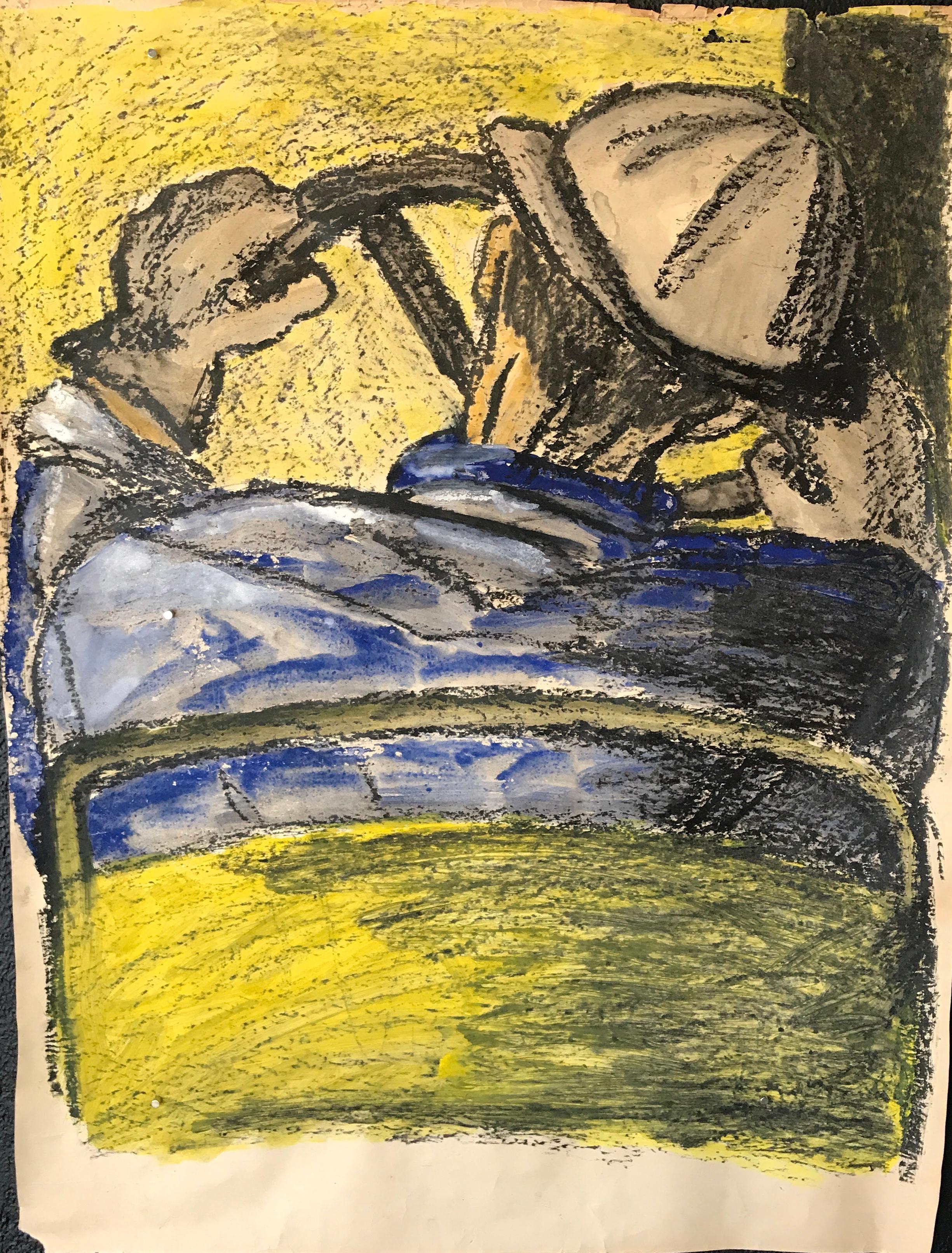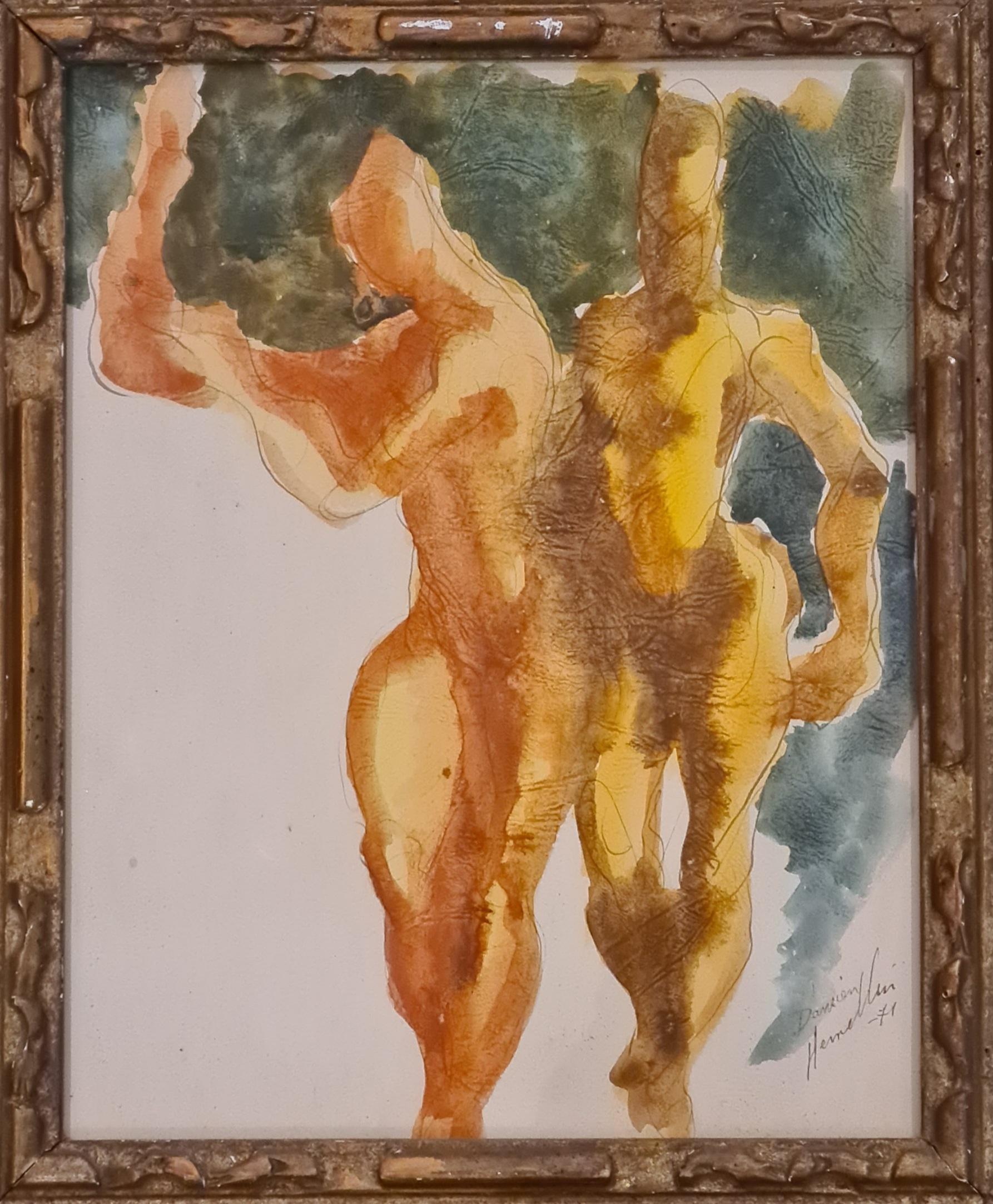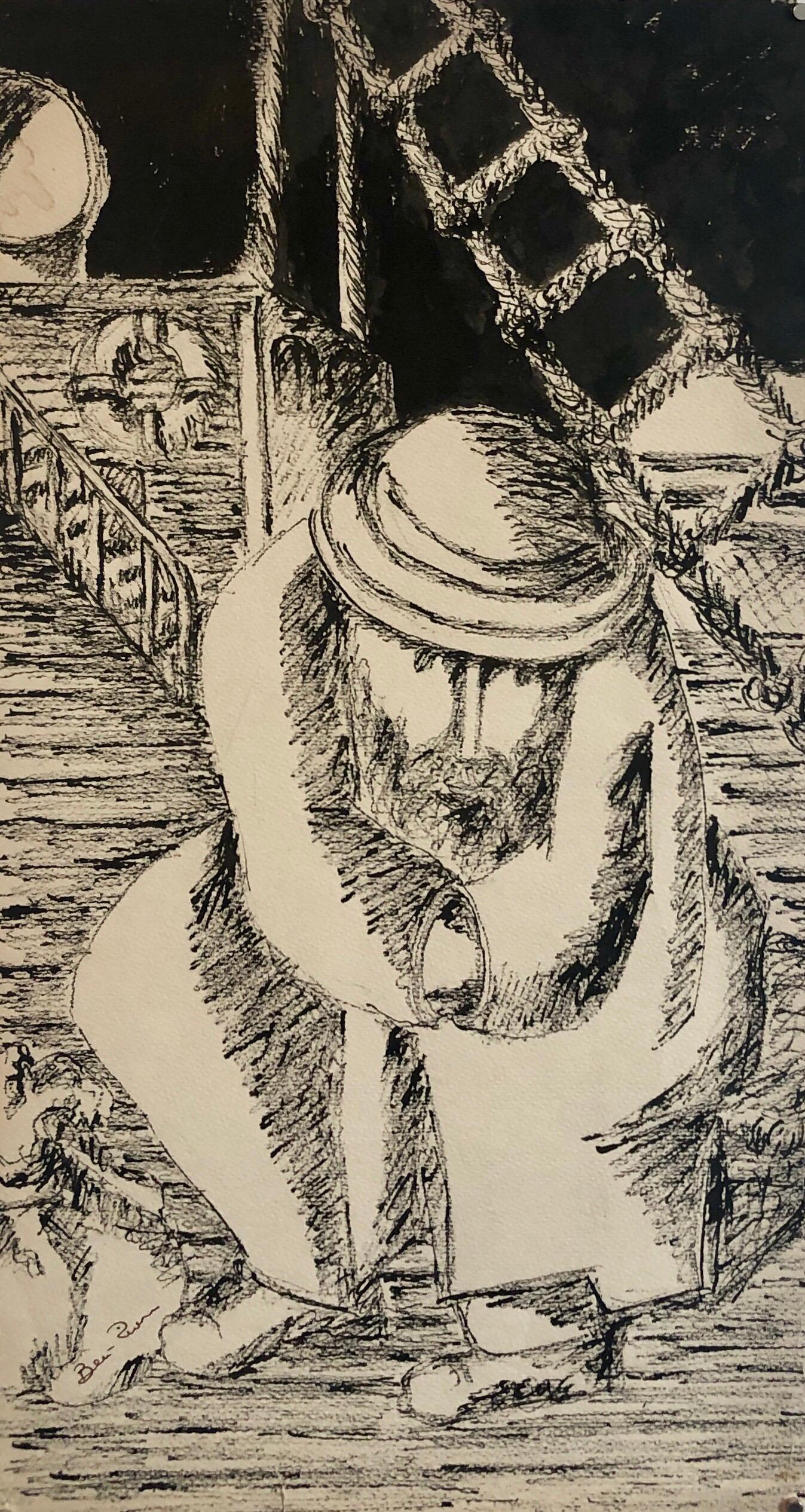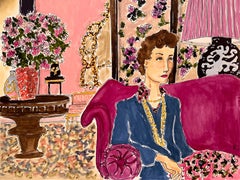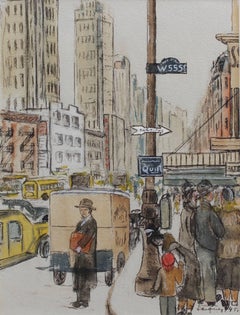
New York West 55th Street
View Similar Items
Want more images or videos?
Request additional images or videos from the seller
1 of 14
Albert JacquezNew York West 55th Street1945
1945
About the Item
About the Seller
5.0
Platinum Seller
These expertly vetted sellers are 1stDibs' most experienced sellers and are rated highest by our customers.
Established in 2016
1stDibs seller since 2017
438 sales on 1stDibs
More From This SellerView All
- Church of Saint-Nicolas du Chardonnet in ParisBy Lucien GéninLocated in London, GB'The Church of Saint-Nicolas du Chardonnet, Paris', gouache on art paper by Lucien Génin (circa 1930s). In Paris' 5th Arrondissement the site in which Saint-Nicolas du Chardonnet is ...Category
1930s Expressionist Figurative Paintings
MaterialsPaper, Gouache
$1,638 Sale Price20% Off - Emile's TavernBy Lucien GéninLocated in London, GB'Emile's Tavern', gouache on paper (circa 1930s), by Lucien Génin. A tavern in French is called a 'guinguette'. With the rise in living standards from the 1860s along with the develo...Category
1930s Expressionist Figurative Paintings
MaterialsPaper, Gouache
$1,740 Sale Price20% Off - Sacré-Coeur Montmartre at Willette Square ParisBy Lucien GéninLocated in London, GB'Sacré-Coeur, Montmartre at Willette Square, Paris', gouache on art paper (circa 1930s), by Lucien Génin. Created by the Director of Public Ways and Promenades under Napoleon III, Sq...Category
1930s Expressionist Figurative Paintings
MaterialsPaper, Gouache
$2,150 Sale Price20% Off - Chinatown, San FranciscoBy Edward Wilson CurrierLocated in London, GB'Chinatown, San Francisco', gouache on fine art paper, by Edward Wilson Currier (1903). Spofford Alley in San Francisco's Chinatown is best known for an address (number 36) where Dr. Sun Yat-Sen plotted the overthrow of China's last dynasty. During Prohibition, it was the site of turf battles over local bootlegging and protection rackets. Today it is lined with seniors' community centres. However, the quiet alley livens up in the evenings when a Chinese orchestra strikes up a tune, mah-jongg games begin with a cascade of clicking tiles, and barbers and florists use the pretence of sweeping their doorsteps to gossip. In this artist's depiction, a man smokes a long-stemmed Chinese pipe under the awning and colourful lanterns hanging from the wooden supports while a child looks on. The artwork is interesting from several standpoints including architectural, cultural and historical. Shortly after this work was painted, the neighbourhood was completely destroyed in the 1906 earthquake that levelled most of the city. From 1910 to 1940, Chinese immigrants were detained at the Angel Island...Category
Early 1900s Expressionist Figurative Drawings and Watercolors
MaterialsGouache, Paper
$2,239 Sale Price30% Off - Paris la BourseBy Lucien GéninLocated in London, GB'Paris, la Bourse', gouache on paper, by Lucien Génin (circa 1930s). Created at the beginning of the 19th century by Napoleon, la Bourse, or the Stock Exchange, was intended to assert and encourage France’s prosperity in industry and trade. In 1826 the Stock Exchange was installed in the palace that the architect Brongniart had begun in 1808. Surrounded by a large peristyle of Corinthian columns, the rectangular structure reflects the official neo-classicism of the Empire Period. The artist, Génin, depicts a typically lively 1930s day in front of the building with cars of the period zooming by pedestrians on the walkway and others on the stairs leading to the entrance. He has an extremely charming, almost childlike style particularly the way he renders the people and the vehicles. The building, on the other hand, is accurate in its detail and more seriously presented. Our gallery has held and has sold over a dozen of Genin's paintings but this one stands out for its pure stylish appeal and ability to captivate while inducing a smile in the viewer. The artwork is in good overall condition - there are some minor blemishes not on the artwork itself but on the edges of the mount to which it is attached. The frame is in fair condition showing some nicks and scratches. Please enjoy the many photos accompanying the listing. Upon request a video can be provided. Signed by the artist in the lower right hand. About the Artist: After the devastation of the First World War, Lucien Génin (1894 - 1953) left his provincial home in the autumn of 1919 to find his fortune among the lively Parisians in the heart of Montmartre. Génin befriended the painters Frank Will, Gen Paul, Émile Boyer...Category
1930s Figurative Paintings
MaterialsGouache
$2,150 Sale Price30% Off - 'International Bar', French SchoolLocated in London, GB'International Bar, pencil, ink and gouache on card stock by an unnamed artist of the French School (20th Century). This appears to be a fantastical port visit of the artist's imagination. It is very lively in colour and in subject. The artwork was discovered in Paris along with several others of the same character, most likely by the same person. It depicts the entryway of a brightly lit Asian bar...Category
20th Century Figurative Drawings and Watercolors
MaterialsInk, Gouache, Pencil
$627 Sale Price30% Off
You May Also Like
- Sonia Spider Quenell, Watercolor portrait on archive paper.By Manuel SantelicesLocated in Miami Beach, FLSonia "Spider" Quenell by Manuel Santelices Ink pen, watercolor, and gouache Image size: 11" x 14" Unframed 2022 Manuel Santelices explores the world of fashion, society, and pop c...Category
21st Century and Contemporary Contemporary Figurative Drawings and Water...
MaterialsInk, Paper, Watercolor, Gouache, Pen
- The Abduction of the Sabine Women , a Renaissance drawing by Biagio PupiniLocated in PARIS, FRThis vigorous drawing has long been attributed to Polidoro da Caravaggio: The Abduction of the Sabine Women is one of the scenes that Polidoro depicted between 1525 and 1527 on the façade of the Milesi Palazzo in Rome. However, the proximity to another drawing inspired by this same façade, kept at the Ecole des Beaux-Arts, and to other drawings inspired by Polidoro kept at the Musée du Louvre, leads us to propose an attribution to Biagio Pupini, a Bolognese artist whose life remains barely known, despite the abundant number of drawings attributed to him. 1. Biagio Pupini, a Bolognese artist in the light of the Roman Renaissance The early life of Biagio Pupini, an important figure of the first half of the Cinquecento in Bologna - Vasari mentions him several times - is still poorly known. Neither his date of birth (probably around 1490-1495) nor his training are known. He is said to have been a pupil of Francesco Francia (1450 - 1517) and his name appears for the first time in 1511 in a contract with the painter Bagnacavallo (c. 1484 - 1542) for the frescoes of a church in Faenza. He then collaborated with Girolamo da Carpi, at San Michele in Bosco and at the villa of Belriguardo. He must have gone to Rome for the first time with Bagnacavallo between 1511 and 1519. There he discovered the art of Raphael, with whom he might have worked, and that of Polidoro da Caravaggio. This first visit, and those that followed, were the occasion for an intense study of ancient and modern art, as illustrated by his abundant graphic production. Polidoro da Caravaggio had a particular influence on the technique adopted by Pupini. Executed on coloured paper, his drawings generally combine pen, brown ink and wash with abundant highlights of white gouache, as in the drawing presented here. 2. The Abduction of the Sabine Women Our drawing is an adaptation of a fresco painted between 1525 and 1527 by Polidoro da Caravaggio on the façade of the Milesi Palace in Rome. These painted façades were very famous from the moment they were painted and inspired many artists during their stay in Rome. These frescoes are now very deteriorated and difficult to see, as the palace is in a rather narrow street. The episode of the abduction of the Sabine women (which appears in the centre of the photo above) is a historical theme that goes back to the origins of Rome and is recounted both by Titus Livius (Ab Urbe condita I,13), by Ovid (Fasti III, 199-228) and by Plutarch (II, Romulus 14-19). After killing his twin brother Romus, Romulus populates the city of Rome by opening it up to refugees and brigands and finds himself with an excess of men. Because of their reputation, none of the inhabitants of the neighbouring cities want to give them their daughters in marriage. The Romans then decide to invite their Sabine neighbours to a great feast during which they slaughter the Sabines and kidnap their daughters. The engraving made by Giovanni Battista Gallestruzzi (1618 - 1677) around 1656-1658 gives us a good understanding of the Polidoro fresco, allowing us to see how Biagio Pupini reworked the scene to extract this dynamic group. With a remarkable economy of means, Biagio Pupini takes over the left-hand side of the fresco and depicts in a very dense space two main groups, each consisting of a Roman and a Sabine, completed by a group of three soldiers in the background (which seems to differ quite significantly from Polidoro's composition). The balance of the drawing is based on a very strongly structured composition. The drawing is organised around a median vertical axis, which runs along both the elbow of the kidnapped Sabine on the left and the foot of her captor, and the two main diagonals, reinforced by four secondary diagonals. This diamond-shaped structure creates an extremely dynamic space, in which centripetal movements (the legs of the Sabine on the right, the arm of the soldier on the back at the top right) and centrifugal movements (the arm of the kidnapper on the left and the legs of the Sabine he is carrying away, the arm of the Sabine on the right) oppose each other, giving the drawing the appearance of a whirlpool around a central point of support situated slightly to the left of the navel of the kidnapper on the right. 3. Polidoro da Caravaggio, and the decorations of Roman palaces Polidoro da Caravaggio was a paradoxical artist who entered Raphael's (1483 - 1520) workshop at a very young age, when he oversaw the Lodges in the Vatican. Most of his Roman work, which was the peak of his career, has disappeared, as he specialised in facade painting, and yet these paintings, which are eminently visible in urban spaces, have influenced generations of artists who copied them abundantly during their visits to Rome. Polidoro Caldara was born in Caravaggio around 1495-1500 (the birthplace of Michelangelo Merisi, known as Caravaggio, who was born there in 1571), some forty kilometres east of Milan. According to Vasari, he arrived as a mason on the Vatican's construction site and joined Raphael's workshop around 1517 (at the age of eighteen according to Vasari). This integration would have allowed Polidoro to work not only on the frescoes of the Lodges, but also on some of the frescoes of the Chambers, as well as on the flat of Cardinal Bibiena in the Vatican. After Raphael's death in 1520, Polidoro worked first with Perin del Vaga before joining forces with Maturino of Florence (1490 - 1528), whom he had also known in Raphael's workshop. Together they specialised in the painting of palace façades. They were to produce some forty façades decorated with grisaille paintings imitating antique bas-reliefs. The Sack of Rome in 1527, during which his friend Maturino was killed, led Polidoro to flee first to Naples (where he had already stayed in 1523), then to Messina. It was while he was preparing his return to the peninsula that he was murdered by one of his assistants, Tonno Calabrese, in 1543. In his Vite, Vasari celebrated Polidoro as the greatest façade decorator of his time, noting that "there is no flat, palace, garden or villa in Rome that does not contain a work by Polidoro". Polidoro's facade decorations, most of which have disappeared as they were displayed in the open air, constitute the most important lost chapter of Roman art of the Cinquecento. The few surviving drawings of the painter can, however, give an idea of the original appearance of his murals and show that he was an artist of remarkable and highly original genius. 4. The façade of the Milesi Palace Giovanni Antonio Milesi, who commissioned this palace, located not far from the Tiber, north of Piazza Navona, was a native of the Bergamo area, like Polidoro, with whom he maintained close friendly ties. Executed in the last years before the Sack of Rome, around 1526-1527, the decoration of Palazzo Milesi is considered Polidoro's greatest decorative success. An engraving by Ernesto Maccari made at the end of the nineteenth century allows us to understand the general balance of this façade, which was still well preserved at the time. The frescoes were not entirely monochrome, but alternated elements in chiaroscuro simulating marble bas-reliefs and those in ochre simulating bronze and gold vases...Category
16th Century Old Masters Figurative Drawings and Watercolors
MaterialsInk, Gouache, Pen
- Glassblowers WPA American Scene Mid- 20th Century Modern Figurative Workers 1932By Harry GottliebLocated in New York, NYGlassblowers WPA American Scene Mid- 20th Century Modern Figurative Workers. Dated and signed "32 Harry Gottlieb" lower right. Sight: 13 1/8" H x 18 1/4" W. Harry Gottlieb, painter, screenprinter, educator, and lithographer, was born in Bucharest, Rumania. He emigrated to America in 1907, and his family settled in Minneapolis. From 1915 to 1917, Gottlieb attended the Minneapolis Institute of Arts. After a short stint as an illustrator for the U.S. Navy, Gottlieb moved to New York City; he became a scenic and costume designer for Eugene O"Neill's Provincetown Theater Group. He also studied at the Philadelphia Academy of Fine Arts and the National Academy of Design. He was one of America's first Social Realist painters, influenced by that Robert Henri-led movement in New York City where Gottlieb settled in 1918. He was also a pioneer in screen printing, which he learned while working for the WPA. He married Eugenie Gershoy, and the couple joined the artist colony at Woodstock, New York. He lectured widely on art education. In 1923, Gottlieb settled in Woodstock, New York and in 1931, spent a a year abroad studying under a Guggenheim Fellowship. In 1935, he joined the Federal Art Project...Category
1930s American Modern Figurative Paintings
MaterialsPaper, Gouache
- 1950s "Mark" Oil Pastel and Gouache Figurative Painting NYC Modern Mid CenturyBy Donald StacyLocated in Arp, TXDonald Stacy "Mark" c.1950s Oil pastel and gouache paint on paper 14x17" unframed Unsigned Came from artist's estate Donald Stacy (1925-2011) New Jersey Studied: Newark School of ...Category
Mid-20th Century Modern Figurative Paintings
MaterialsGouache, Paper, Oil Pastel
- Mid Century "Driver with Hard Hat" Gouache and Oil Pastel Figurative 1960s SFBy Gloria DudfieldLocated in Arp, TXGloria Dudfield Driver with Hard Hat 1960s Gouache and Oil Pastel on Paper 27"x36" unframed $700 *Custom framing available for additional charge. Please expec...Category
Mid-20th Century American Modern Figurative Drawings and Watercolors
MaterialsOil Pastel, Paper, Gouache
- Chicago Jewish Modernist Judaica Painting Simchat Torah WPA Artist Israeli FlagsBy Alexander Raymond KatzLocated in Surfside, FLThis has young ISraeli pioneers dancing with the flag as typical of works of the late British mandate Palestine era early state of Israel. Genre: Modern Subject: Figurative (stained glass style) Medium: Mixed media gouache on paper Hand signed lower left Alexander Raymond Katz, Hungarian / American (1895 – 1974) Alexander Raymond Katz was born in Kassa, Hungary, and came to the United States in 1909. He studied at the Art Institute of Chicago and the Chicago Academy of Fine Arts. In the late 1920s, he worked as a director of the Poster Department at Paramount Studios. He was appointed the Director of Posters for the Chicago Civic Opera in 1930. During the Great Depression, notable architect Frank Lloyd Wright urged Katz to become a muralist. In 1933, he was commissioned to paint a mural for the Century of Progress exposition in Chicago. In 1936, he painted the mural History of the Immigrant for the Madison, Ill., post office. Katz’s works were included in various exhibitions and now are part of several museum collections, including those of the Art Institute of Chicago; Corcoran Gallery of Art, Washington, D.C.; and the Jewish Museum, New York. His murals, bas-reliefs and stained glass designs adorn more than 200 Jewish synagogues in the United States. Katz and other Jewish artists in Chicago who expressed Jewish and Biblical themes were inspired by the artist Abel Pann (1883-1963). Pann, who is regarded as the leading painter of the Land of Israel, exhibited in the Art Institute of Chicago in 1920. Early in his career, Katz began to explore the artistic possibilities inherent in the characters of the Hebrew alphabet. He developed aesthetic and philosophical interpretations of each letter and became the leading innovator and pioneer in the field of Hebraic art. Katz applies this concept in the woodcut Moses and the Burning Bush. Hebrew letters appears in Moses’ head, his cane and inside the flame. The initial of Moses’ name crowns his head. The letter in the flame is the first letter of the name of God. A combination of images and Hebrew letters appeared commonly in illustrations of the scene Moses and the Burning Bush in the Haggadah, the book of Passover. The symbolism of the burning bush corresponds to the motifs of A Gift to Biro-Bidjan. Among the fourteen participating artists were notable Chicago modernists Todros Geller, Mitchell Siporin...Category
Mid-20th Century Modern Figurative Paintings
MaterialsPaper, Gouache
Recently Viewed
View AllMore Ways To Browse
Vintage New York Hat
Vintage Cross Pens
Vintage Cross Pen
Watercolor Painting Ballet
French Chalk Art
Ivory Woman
Black And White Watercolor Sketches
Ink Drawings 18th Century
Watercolor Christmas Painting
Erotic Female Nude Paintings
Sepia Drawing
Pencil 18th
Small Pen And Ink Drawings
Morocco Watercolor
Watercolor Framed Set Of 2
Engraving Stained Glass
French Art Deco Watercolor Paintings
Vintage Drawing Woman


